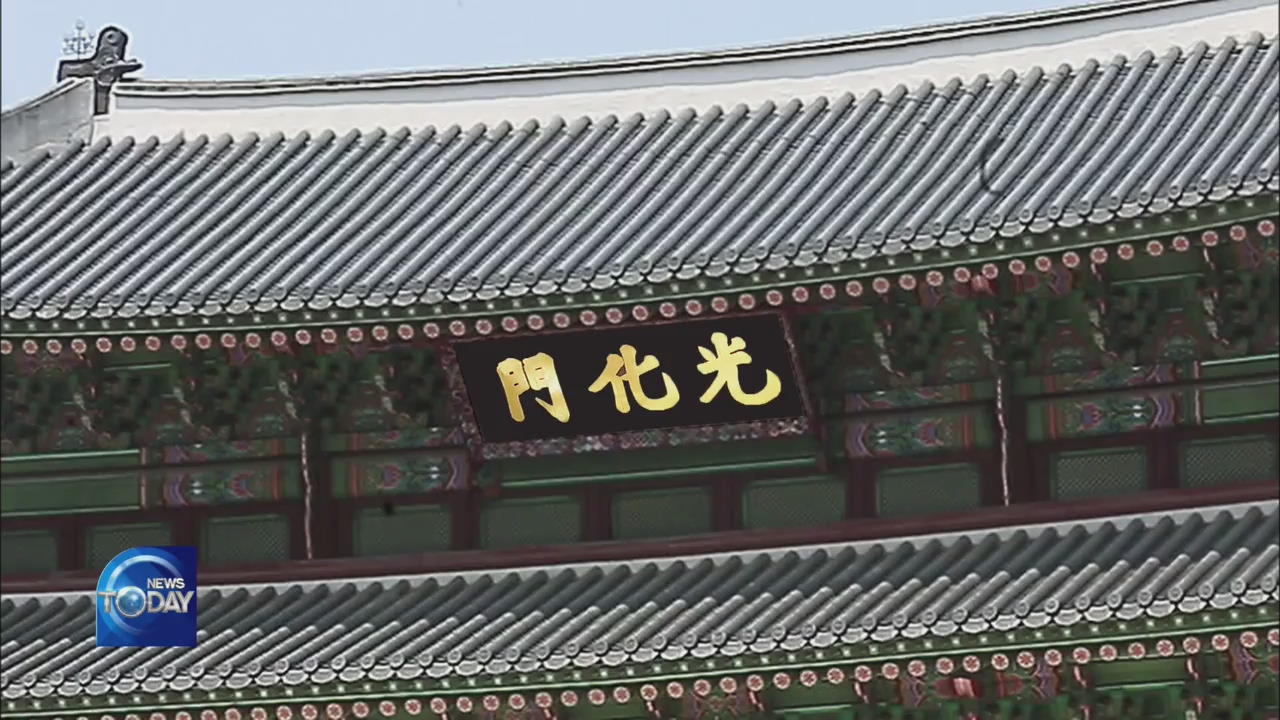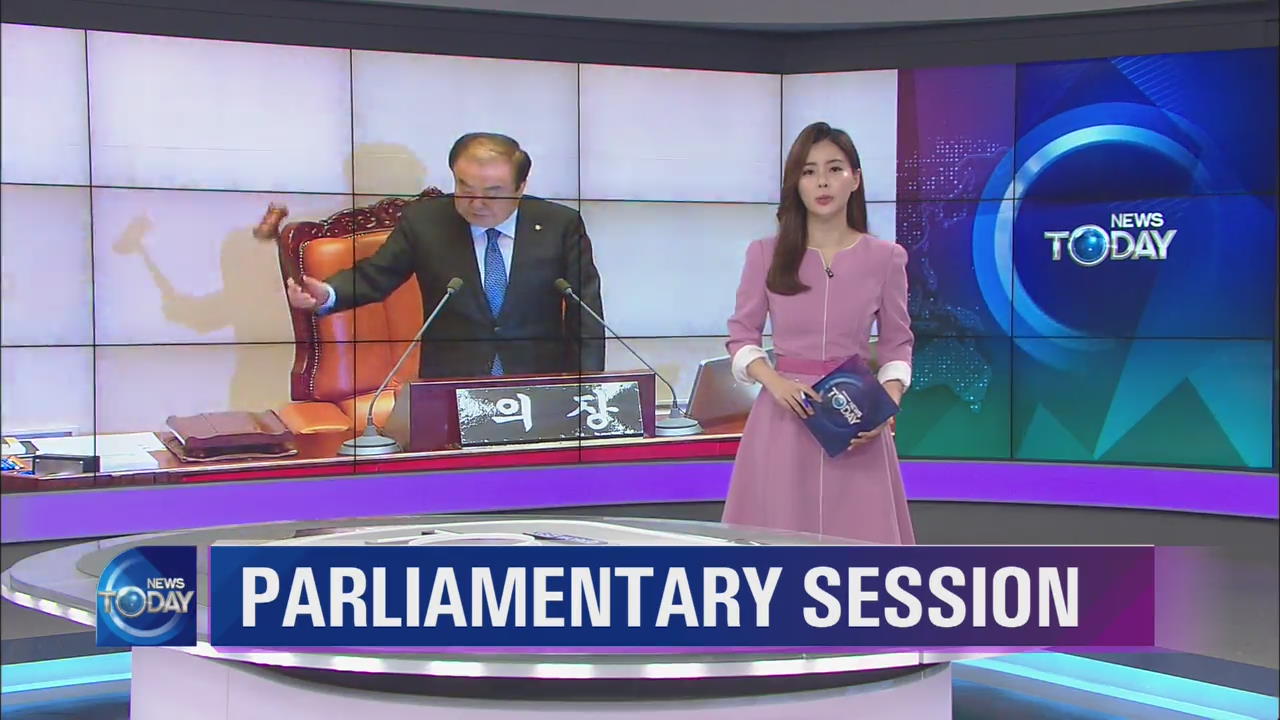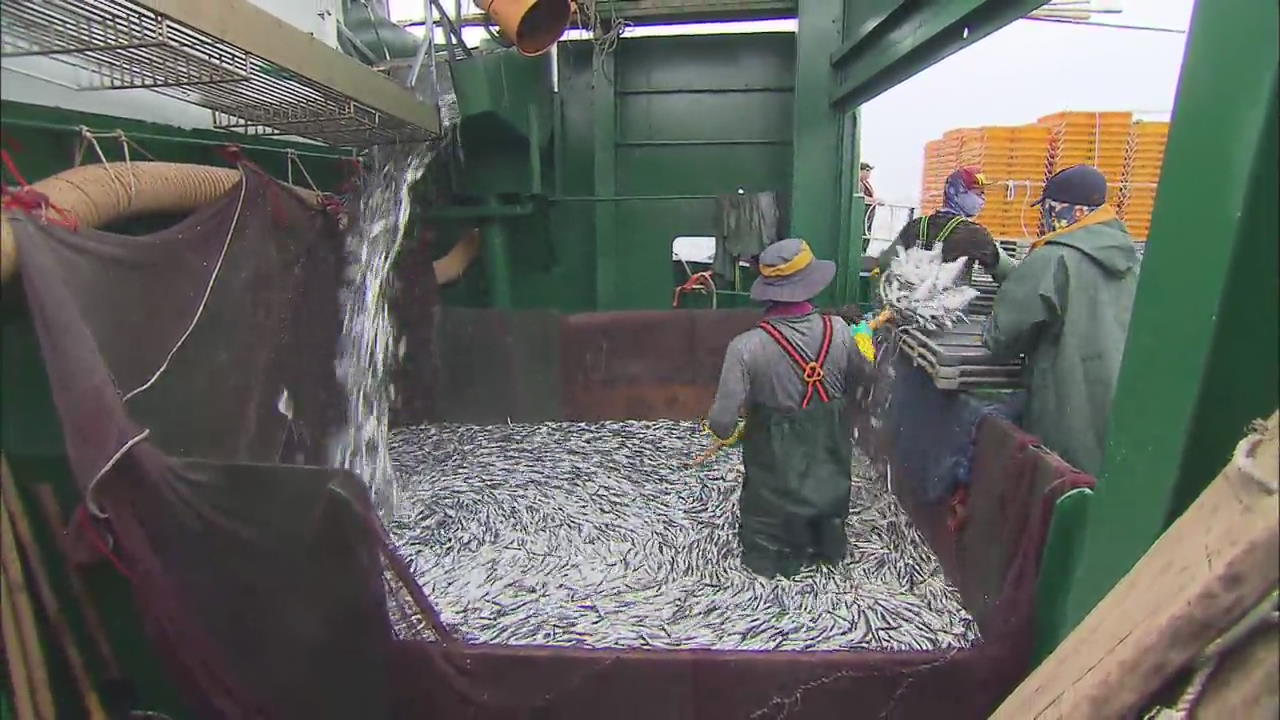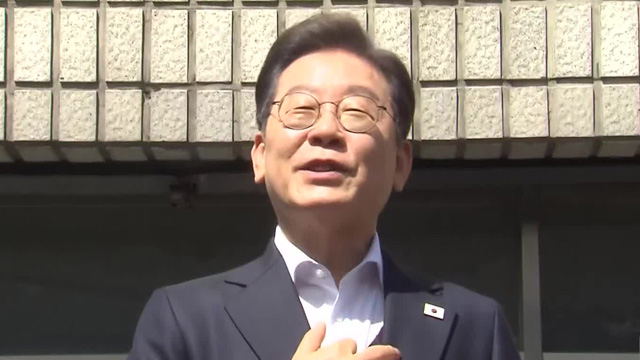GWANGHWAMUN GATE CHANGE
입력 2019.07.02 (15:24)
수정 2019.07.02 (17:10)
읽어주기 기능은 크롬기반의
브라우저에서만 사용하실 수 있습니다.
[Anchor Lead]
The signboard of the Gwanghwamun Gate in downtown Seoul features black letters on a white background. But a new design is being pursued after the current pattern was confirmed to be different from the original. Let's take a quick look at the new design
[Pkg]
This is the signboard that was unveiled on Independence Day in 2010 for the renovated Gwanghwamun Gate in Seoul. Not long after the unveiling, cracks were discovered, prompting a decision to replace it. Afterward, KBS released a photo showing the signboard originally having a black background, rather than the white of the current design. In more recent days, documents from the King Gojong era have confirmed that the letters on the signboard were of gold color covered in copperplate. Based on these findings, a template for the first character "gwang" has been made on a trial basis. Copperplate was used to form the character on a wooden board and it was then coated with gold leaf.
[Soundbite] LEE JEONG-YEON(CULTURAL HERITAGE ADMINISTRATION) : "We were cautious at first because the original dates back more than a century but we gained confidence through the trial template."
The technique of copperplate characters disappeared after the Japanese colonial era. A craftsman who has been designated an intangible cultural asset was called in to revive this time old skill. Chisels and hammers were used to create the outline, while even the nails used were made in the traditional way.
[Soundbite] PARK MUN-YEOL(INTANGIBLE CULTURAL ASSET NO. 64 METAL CRAFTSMAN) : "It's an emotional task in the sense that I'm reviving an ancient technique."
This is another prototype that was tried out last year. The signboard was divided in half to test both traditional and modern coloring, and to compare and contrast the differences.
[Soundbite] KIM TAE-YEONG(CULTURAL HERITAGE ADMINISTRATION) : "Traditional coloring has a warm feeling while modern paint has better visibility."
The appearance of the new signboard will be finalized by a cultural heritage committee next month. The new look, which portrays the original gilded copper letters on a black background from 150 years ago, will be unveiled some time in the first half of next year.
The signboard of the Gwanghwamun Gate in downtown Seoul features black letters on a white background. But a new design is being pursued after the current pattern was confirmed to be different from the original. Let's take a quick look at the new design
[Pkg]
This is the signboard that was unveiled on Independence Day in 2010 for the renovated Gwanghwamun Gate in Seoul. Not long after the unveiling, cracks were discovered, prompting a decision to replace it. Afterward, KBS released a photo showing the signboard originally having a black background, rather than the white of the current design. In more recent days, documents from the King Gojong era have confirmed that the letters on the signboard were of gold color covered in copperplate. Based on these findings, a template for the first character "gwang" has been made on a trial basis. Copperplate was used to form the character on a wooden board and it was then coated with gold leaf.
[Soundbite] LEE JEONG-YEON(CULTURAL HERITAGE ADMINISTRATION) : "We were cautious at first because the original dates back more than a century but we gained confidence through the trial template."
The technique of copperplate characters disappeared after the Japanese colonial era. A craftsman who has been designated an intangible cultural asset was called in to revive this time old skill. Chisels and hammers were used to create the outline, while even the nails used were made in the traditional way.
[Soundbite] PARK MUN-YEOL(INTANGIBLE CULTURAL ASSET NO. 64 METAL CRAFTSMAN) : "It's an emotional task in the sense that I'm reviving an ancient technique."
This is another prototype that was tried out last year. The signboard was divided in half to test both traditional and modern coloring, and to compare and contrast the differences.
[Soundbite] KIM TAE-YEONG(CULTURAL HERITAGE ADMINISTRATION) : "Traditional coloring has a warm feeling while modern paint has better visibility."
The appearance of the new signboard will be finalized by a cultural heritage committee next month. The new look, which portrays the original gilded copper letters on a black background from 150 years ago, will be unveiled some time in the first half of next year.
■ 제보하기
▷ 카카오톡 : 'KBS제보' 검색, 채널 추가
▷ 전화 : 02-781-1234, 4444
▷ 이메일 : kbs1234@kbs.co.kr
▷ 유튜브, 네이버, 카카오에서도 KBS뉴스를 구독해주세요!
- GWANGHWAMUN GATE CHANGE
-
- 입력 2019-07-02 14:04:29
- 수정2019-07-02 17:10:51

[Anchor Lead]
The signboard of the Gwanghwamun Gate in downtown Seoul features black letters on a white background. But a new design is being pursued after the current pattern was confirmed to be different from the original. Let's take a quick look at the new design
[Pkg]
This is the signboard that was unveiled on Independence Day in 2010 for the renovated Gwanghwamun Gate in Seoul. Not long after the unveiling, cracks were discovered, prompting a decision to replace it. Afterward, KBS released a photo showing the signboard originally having a black background, rather than the white of the current design. In more recent days, documents from the King Gojong era have confirmed that the letters on the signboard were of gold color covered in copperplate. Based on these findings, a template for the first character "gwang" has been made on a trial basis. Copperplate was used to form the character on a wooden board and it was then coated with gold leaf.
[Soundbite] LEE JEONG-YEON(CULTURAL HERITAGE ADMINISTRATION) : "We were cautious at first because the original dates back more than a century but we gained confidence through the trial template."
The technique of copperplate characters disappeared after the Japanese colonial era. A craftsman who has been designated an intangible cultural asset was called in to revive this time old skill. Chisels and hammers were used to create the outline, while even the nails used were made in the traditional way.
[Soundbite] PARK MUN-YEOL(INTANGIBLE CULTURAL ASSET NO. 64 METAL CRAFTSMAN) : "It's an emotional task in the sense that I'm reviving an ancient technique."
This is another prototype that was tried out last year. The signboard was divided in half to test both traditional and modern coloring, and to compare and contrast the differences.
[Soundbite] KIM TAE-YEONG(CULTURAL HERITAGE ADMINISTRATION) : "Traditional coloring has a warm feeling while modern paint has better visibility."
The appearance of the new signboard will be finalized by a cultural heritage committee next month. The new look, which portrays the original gilded copper letters on a black background from 150 years ago, will be unveiled some time in the first half of next year.
The signboard of the Gwanghwamun Gate in downtown Seoul features black letters on a white background. But a new design is being pursued after the current pattern was confirmed to be different from the original. Let's take a quick look at the new design
[Pkg]
This is the signboard that was unveiled on Independence Day in 2010 for the renovated Gwanghwamun Gate in Seoul. Not long after the unveiling, cracks were discovered, prompting a decision to replace it. Afterward, KBS released a photo showing the signboard originally having a black background, rather than the white of the current design. In more recent days, documents from the King Gojong era have confirmed that the letters on the signboard were of gold color covered in copperplate. Based on these findings, a template for the first character "gwang" has been made on a trial basis. Copperplate was used to form the character on a wooden board and it was then coated with gold leaf.
[Soundbite] LEE JEONG-YEON(CULTURAL HERITAGE ADMINISTRATION) : "We were cautious at first because the original dates back more than a century but we gained confidence through the trial template."
The technique of copperplate characters disappeared after the Japanese colonial era. A craftsman who has been designated an intangible cultural asset was called in to revive this time old skill. Chisels and hammers were used to create the outline, while even the nails used were made in the traditional way.
[Soundbite] PARK MUN-YEOL(INTANGIBLE CULTURAL ASSET NO. 64 METAL CRAFTSMAN) : "It's an emotional task in the sense that I'm reviving an ancient technique."
This is another prototype that was tried out last year. The signboard was divided in half to test both traditional and modern coloring, and to compare and contrast the differences.
[Soundbite] KIM TAE-YEONG(CULTURAL HERITAGE ADMINISTRATION) : "Traditional coloring has a warm feeling while modern paint has better visibility."
The appearance of the new signboard will be finalized by a cultural heritage committee next month. The new look, which portrays the original gilded copper letters on a black background from 150 years ago, will be unveiled some time in the first half of next year.
이 기사가 좋으셨다면
-
좋아요
0
-
응원해요
0
-
후속 원해요
0

















이 기사에 대한 의견을 남겨주세요.